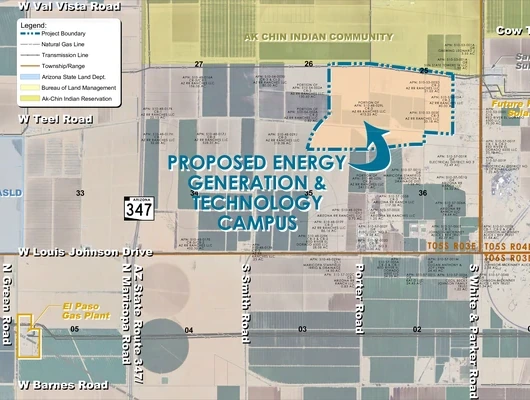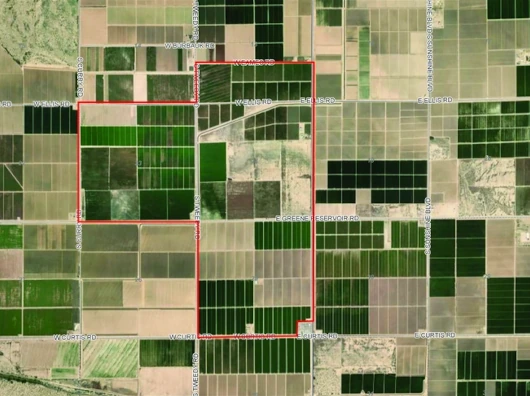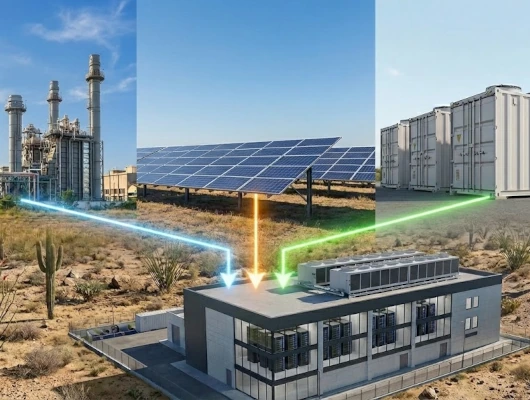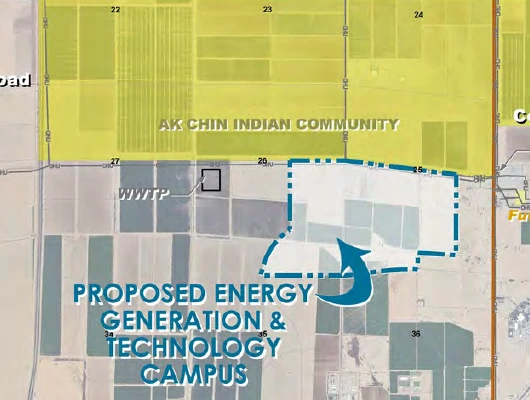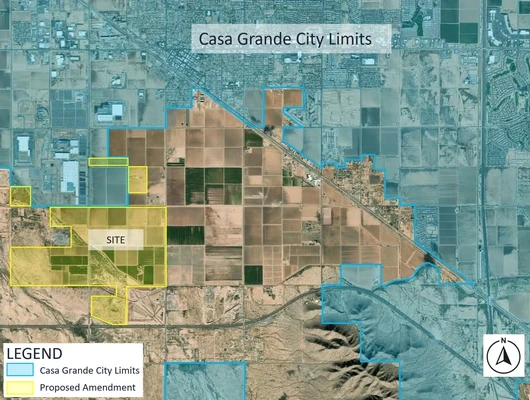At a Glance
- Vote: The Pinal County Planning and Zoning Commission voted 6–2 on October 16 to recommend approval of a 495-acre Energy Generation and Technology Campus south of Maricopa.
- Location: The site borders the Ak-Chin Indian Community’s southern boundary, west of the Nissan Test Track and east of State Route 347.
- Purpose: The project would house data centers, a natural gas power plant, and battery storage, supplied primarily by the Griffin Energy Project southeast of Stanfield, AZ.
- Economic Impact: Developer estimates $4 billion in construction and $5.5 billion in equipment investment, supporting 1,000+ permanent jobs and generating $44 million annually in local tax revenue.
- Water Use: Expected use of 500 acre-feet per year, compared to 931 AFY for approved housing or 1,980 AFY for farming on the same land.
- Fire Coverage: Chief Heaton outlined plans for two new fire stations funded upfront by developers, then by tax revenue.
- Opposition: The Ak-Chin Indian Community and local residents raised cultural, environmental, and noise concerns, urging reconsideration of the site.
- Next Step: The proposal now heads to the Pinal County Board of Supervisors for final action on the comprehensive plan amendment before rezoning or construction can proceed.
This article is a continuation of our previous coverage: Massive Energy and Tech Campus Planned Near Maricopa, Ak-Chin Community
The Pinal County Planning and Zoning Commission voted 6-2 on October 16 to recommend approval of a major comprehensive plan amendment for the Energy Generation and Technology Campus, despite opposition from residents and the Ak-Chin Indian Community.
The project has evolved considerably since commissioners first discussed it during a work session in July, addressing some concerns while leaving others unresolved.
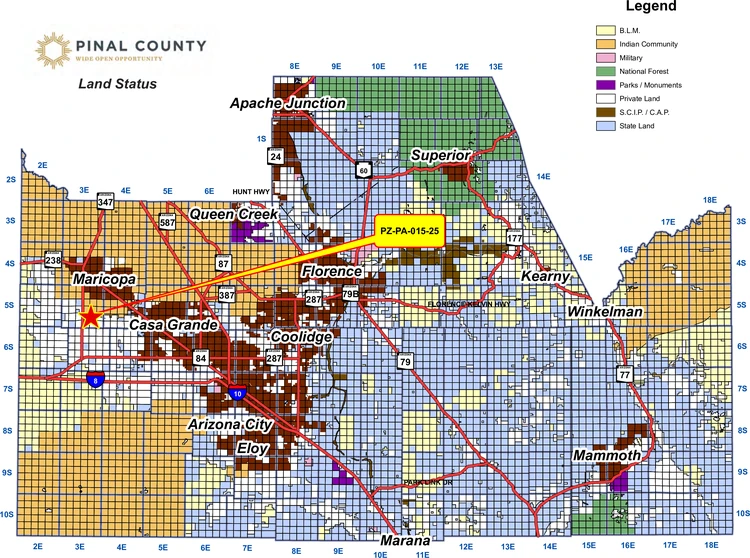
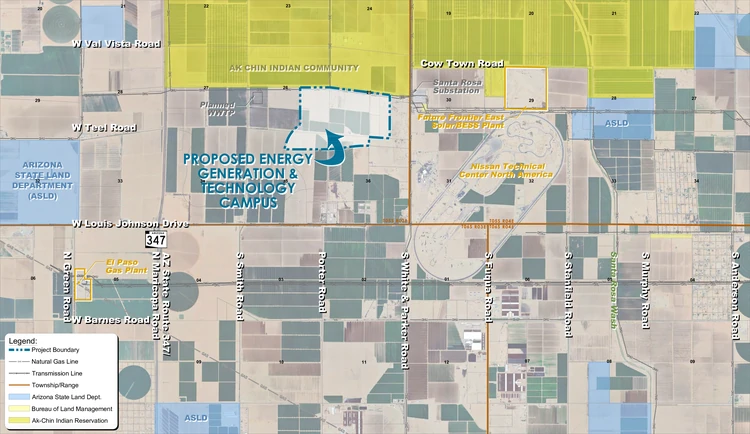
The Agenda Item
The commission reviewed case PZ-PA-015-25, a request to change how the county allows 495 acres of land to be used. The land currently allows homes but would shift to allow an energy and technology campus with data centers, a natural gas power plant, and battery storage systems.
Connection to Griffin Energy Project
This data center campus is designed to be powered primarily by the Griffin Energy solar, gas, and battery project, located across Interstate 8 southeast of Stanfield, that the commission also approved at the same meeting. While Griffin Energy can supply power locally for other purposes, powering this data center is one of its primary objectives.
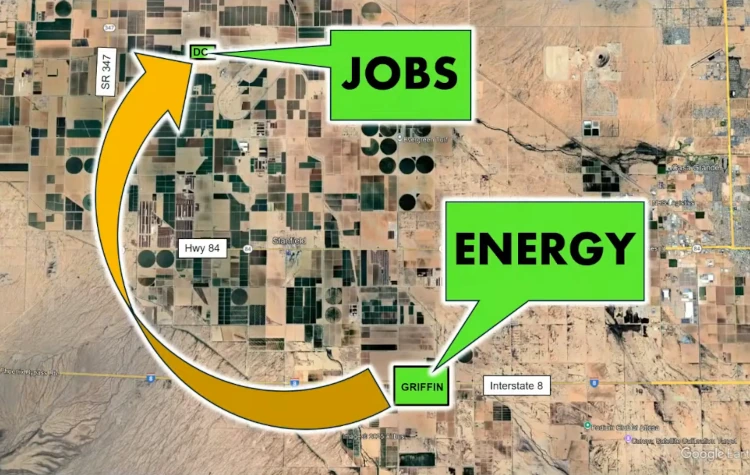
What Changed Since July
The most dramatic change since the work session came in the project’s size. Rose Law Group co-founder Court Rich, representing the developer, explained the site shrank from approximately 2,500 acres to 495 acres after community feedback. Rich said this reduction happened before the Citizens Advisory Committee meeting, which voted 5-8 (with one abstention) to recommend denial in September.
Staff also reported the City of Maricopa changed its position from opposition to neutral after working with the applicant on a pre-annexation development agreement.
The Economic Impact
Rich presented an economic study from Elliott Pollack & Company showing substantial projected benefits. The analysis revealed a $4 billion construction cost plus $5.5 billion in equipment for the facility.
“500 direct permanent jobs at the facility, and another 588 indirect induced jobs,” Rich said. “So that’s over 1,000 permanent jobs that this will generate.”
The study projects $66.2 million annually in wages flowing into the community, with half a billion dollars in construction wages during the building phase.
Tax revenue estimates show $44 million annually, broken down as $9 million to the county, over $20 million in sales tax, and over $6 million to schools each year. Rich emphasized these figures remain consistent year after year, unlike solar projects where property tax revenue declines over time.
“If this were in existence today and we’re in the city of Maricopa, it would be the third-largest employer with the direct jobs in the city of Maricopa today,” Rich said, comparing the facility to current Maricopa employers.
Rich added that schools stand to benefit significantly from the tax revenue. Casa Grande Union High School, with an annual budget of $46 million, would receive $3 to $4 million yearly. Stanfield Elementary School, operating on a $4 million budget, would get approximately $3.6 million annually.
Water Usage Comparison
Rich addressed water concerns by comparing the project’s expected consumption to current approved uses for the land. The property currently has approval for 1,945 homes.
The data center and gas plant would use approximately 500 acre-feet of water per year, compared to 1,980 acre-feet for farming the same acreage and 931.5 acre-feet for the approved housing development.
“We’re 47% less than housing, we’re 75% less than the agricultural uses there,” Rich said.
Fire Services for the Region
Arizona Fire and Medical Authority Chief Jeff Heaton explained plans to establish fire protection in the area, which currently lacks adequate coverage.
“What really kind of drove this too is all the growth off of Papago Ranch… I believe it’s 150-plus homes where nobody’s coming if there’s a fire,” Heaton said. “The whole area in Stanfield, the I-8, from really Gila River over, no one’s really coming.”
Heaton described the funding mechanism that will make new fire stations possible: “We’re going to sign on and get payments up front from these entities so they’ll build a station, buy the equipment, and then provide dollars for manpower to be on those starting before the project comes in. And then, from that point on, it will be supported through tax dollars, and then the growth of residential housing as well.”
The authority plans to place its first station at a previously approved solar plant and a second station near Papago Ranch and John Wayne Parkway.
Maricopa’s Position Shift
The City of Maricopa initially opposed the project in an August letter, citing concerns about conformance with the city’s general plan and loss of future housing stock. However, staff reported Maricopa recently changed to a neutral position.
Rich explained the city’s interest in a pre-annexation development agreement, noting the project’s potential traffic benefits. With 500 jobs located south of Maricopa, workers would travel opposite rush-hour traffic on State Route 347.
“These are 500 less trips going north on the 347 during rush hour, they’re heading the other direction,” Rich said.
Vice-Chairman Robert Klob asked Rich about the implications of annexation for the tax benefits Rich had described. Rich clarified that annexation would add Maricopa as a beneficiary but wouldn’t remove the property from existing school districts.
“The county will still levy a tax on everybody. Even if you’re in the city, you still pay county taxes too,” Rich explained. “The property will pay more in tax after that. Those numbers will go up.”
Ak-Chin Community Opposition
Delia Carlyle, vice-chairwoman of the Ak-Chin Indian Community, delivered strong opposition to the project’s location, which borders the community’s southern boundary.
“While our community does not oppose the proposed development, we are adamantly opposed to the proposed site for this development, which abuts our southern boundary,” Carlyle said. “This location is known to have high concentration of cultural artifacts, and there are just a strong possibility that additional artifacts and cultural remains are there.”
Carlyle asked commissioners to consider the significance of disturbing cultural remains: “When we talk about remains, how would you feel if your loved ones were dug up, disturbed? That’s how we feel when ground disturbance happens and we’re not notified of that.”
She emphasized the tribe has never sought to stop projects entirely but wants the opportunity to protect cultural resources. “We’ve always said we never wanted to stop any project, but give us the opportunity to be able to go back onto those lands and bring back our loved ones home so they won’t be disturbed,” Carlyle said.
The vice-chairwoman noted artifacts represent not just tribal history but Arizona’s broader heritage, referencing nearby petroglyphs that have been damaged. “That’s not our history, that’s also a piece of Arizona history,” she said.
Carlyle highlighted the unique constraints facing the tribe: “Please keep in mind that our reservation, we don’t have the luxury of selling our land and moving elsewhere. ‘Cause why would we? That’s our home. But we can’t do that.”
She described the tribe’s identity as farmers, noting “we were farmers and that’s where we established our location from our ancestors who farmed in the area near Vekol Wash, which in turn, eventually became our community.”
Rich responded by offering to have a cultural resource officer on site during construction. “We’re happy to have them have a cultural resource officer on site during construction and during earth movement, whatever they want, we’re totally good with,” Rich said.
Longtime Resident Tied to John Wayne Ranch Raises Concerns
Alice Johnson-McKinney, a 56-year resident of the area, expressed opposition despite having what she described as good relationships with the developers. Her late husband, Louis Johnson, co-owned with John Wayne the 50,000-acre 26 Bar Ranch in Arizona, a major Hereford cattle operation and family gathering place for the Waynes.
“If you don’t stand for something, you’ll fall for anything,” Johnson-McKinney said, quoting a saying from her family. “I’m not comfortable with what’s going on. It’s a mile from my house.”
Johnson-McKinney worried about noise from the facility: “I’m pretty adamant about the farmland. I sleep really well. There’s no noise. I can get on my front porch and have coffee.”
She described visiting data centers this week and speaking with nearby residents. “I even stopped a man walking down the street that lived in the area and asked him about it. He did say there was a constant noise,” Johnson-McKinney said. “He said, ‘When the generators come on, that’s really noisy.’ So I said, ‘Well, I just wanted to ask you how you felt about it ’cause there’s one that might be going in Pinal County.’ He said, ‘Don’t do it.'”
While the developers assured her the facility would use state-of-the-art technology to minimize noise, Johnson-McKinney said, “Now these guys are telling me that this will be state-of-the-art and I won’t hear that constant hum, and I hope not, but if I do, I can live with it.”
She expressed broader concerns about agricultural land loss: “I’m not against progress, but the farmland is special. Nobody wants to think about this, but there’s going to come a day when there will not be enough farmland to serve food for our own population.”
Additional Public Comments
Tena Dugan questioned the accountability measures for the project’s promises and expressed skepticism about job numbers, noting the national average for data center employment is around 50 people working 24/7 rather than the 550 on-site jobs claimed.
Savannah Morrison provided extensive data on data center impacts nationwide. “In 2018, we had a thousand data centers that consumed approximately 11 gigawatts, a large power plant generates about one gigawatt, and they emitted 31.5 million metric tons of greenhouse gases,” Morrison said. “From 2018 to 2021, that number more than doubled to a total of 2,600 and then doubled again in the following four years. As of March 2025, there are 5,426 data centers consuming up to 17 gigawatts with projections set to increase up to 130 gigawatts.”
Morrison also cited electricity cost impacts: “A Bloomberg analysis of wholesale electricity from areas with high data center activity showed a 267% increase compared to five years prior. The market watchdog for the Mid-Atlantic showed a 670% increase as some of these places try to draw on centers with subsidized rates. The Arizona Public Service alone approved a rate hike of 8% for residential, while only a 3.4% for businesses like data centers.”
Cepand Alizadeh, a government relations specialist with the Arizona Technology Council, spoke in support while acknowledging the need to respect tribal and farming history while embracing progress in the 21st century.
Brian Yerges from Electrical District No. 3 explained why the location makes sense from an infrastructure standpoint, noting four major substations converge in the area: SRP Duke, APS Santa Rosa, Western Area Power Administration Test Track, and Electrical District Number Three Maricopa.
Robin Davis, a Hidden Valley resident, said: “I want to keep Thunderbird Farms and I want to keep Hidden Valley rural” and protect their rural character.
Commission Discussion and Vote
Commissioner Tom Scott acknowledged the project’s economic benefits but emphasized the importance of listening to citizens who stayed through the long meeting.
“I think it’s important that we take value in their desires and their concerns because it’s them that this very commission serves,” Scott said. “I just want you to know, citizens, that I’ve heard your comments and your concerns tonight.”
Vice-Chairman Klob expressed being conflicted. “Professionally, I’m in a world that is changing incredibly fast with AI and data and technology and where there’s a distinct possibility that my job and my career will be gone in the next 10 years because of where AI is going,” Klob said. “One of my biggest challenges with a lot of these solar and alternative energy sites has always been what’s the benefit to the community? And so finally we get one that comes and says, ‘We’re gonna create a benefit, we’re gonna create jobs.'”
Commissioner Karen Mooney moved to recommend denial, with Scott seconding. However, that motion failed. Commissioner Daren Schnepf then moved to recommend approval to the Board of Supervisors.
The final vote was 6-2 in favor of approval, with Commissioners Mooney and Scott voting against the recommendation.
What’s Next
The case now advances to the Pinal County Board of Supervisors for final consideration of the comprehensive plan amendment. If approved, the applicant will return with rezoning and Planned Area Development requests.
